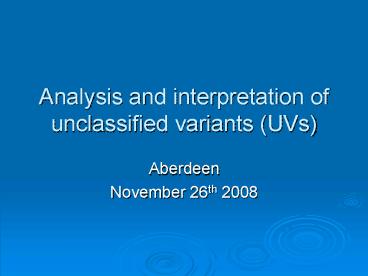Analysis and interpretation of unclassified variants UVs - PowerPoint PPT Presentation
1 / 16
Title:
Analysis and interpretation of unclassified variants UVs
Description:
Can occur either in the coding region of the gene, or in the intronic, 5' ... Occurs in functional domain; conserved in 8 available sequences (human-zebrafish) ... – PowerPoint PPT presentation
Number of Views:176
Avg rating:3.0/5.0
Title: Analysis and interpretation of unclassified variants UVs
1
Analysis and interpretation of unclassified
variants (UVs)
- Aberdeen
- November 26th 2008
2
What is a UV?
- Novel sequence change detected in a gene of
interest - Clinical significance of the variant is unknown
- Can occur either in the coding region of the
gene, or in the intronic, 5UTR or 3UTR regions - Usually substitutions but may also include
in-frame deletions/insertions
3
How common are they?
- In BRCA1 represent 27 of the sequence
changes detected (excluding common neutral
variants) - no cases to date of UV in both BRCA1/2 genes
- In Long QT represent 29 (minimum) of the
sequence changes detected (excluding common
variants) - no cases to date of UV in gt1 gene
- Problems arise when reporting these variants
are they responsible for the phenotype or are
they novel, rare variants of no clinical
significance??
4
Guidelines for analysis and reporting
- Best Practice Meeting (CMGS) April 2007
- Formed an agreed set of standards that
laboratories should follow to assist in
determination of the clinical significance of
these variants - http//cmgsweb.shared.hosting.zen.co.uk/BPGs/pdfs
20current20bpgs/UV20GUIDELINES20ratified.pdf
5
Lines of evidence
- Literature, mutation databases (curated?), SNP
databases - Testing controls
- Co occurrence in trans with deleterious mutations
- Co-segregation with phenotype in family
- De novo variant occurrence
- Species conservation
- In silico prediction- missense and splicing
effects - RNA/splicing studies
- Functional studies
- Not all possible for each variant
- Summarise results and decide on likelihood of
pathogenicity
6
Intronic variants
- In silico analysis programmes available Splicing
sequences finder EMBL - alternative splicing site Fruitfly etc
- Approximately 1/3 of UVs in BRCA1 and LQT are
intronic
7
Intronic considerations
- Dependent on region of intronic variant only
some programmes available- consensus of results - Nonsense mediated decay - site of variant in gene
- Establishing both copies present in RNA studies
if no effect other variants in region of
interest - Level of gene expression in tissue available for
RNA work - Are we identifying all intronic variants of
interest dependent on position of primers in
screen
8
BRCA1 c.5194-12GgtA
- Not detected previously in over 1000 control
chromosomes - Not in SNP databases
- Recorded several times in BIC database unknown
clinical significance - In silico analysis (3/5) suggests putative
cryptic splice site created - Three affected family members (3 generations)
demonstrate sequence change - Likely to be pathogenic????
9
BRCA1 c.5194-12GgtA
Sequencing revealed new splice site created at
site of variantled to inclusion of 10bp
intronic sequence in transcript to create
frameshift mutation
exon19/ exon20
AAA ATG CTG AAT GAG /CAT GAT
TTT GAA (WT) A
ATG AG T TTC TTT CAG CAT GAT TTT GAA (NEW)
fsx5
Lower level of mutant sequence detected
efficiency of new site/degradation of
mutant? Likely to be cause of phenotype
pathogenic?? More family members.. unaffecteds?
10
KCNQ1 c.478-56TgtG
- Sudden death case - 12 year old boy (playing
football) - Not detected previously in over 200 control
chromosomes - Not in SNP databases, or inherited arrhythmias
mutation databases - No other variants in KCNQ1, KCNH2 (to date)
- In silico analysis (3/3) suggests branch point
destroyed - But no other tissue available .
- No other affected family member
- Have requested parental samples
11
Missense variants
In silico analysis programmes available Clustal,
SIFT, Polyphen, Align GVGD etc
12
Missense considerations
- Availability of suitable sequences for
conservation analysis - Range of available sequences wide spectrum of
species (human to pufferfish ideal) - Alignments (own vs programme)
- Basis of analysis residue conservation vs
structural vs chemical difference - Functional studies dependent on gene and region
of gene that variant resides - Effect on splicing if at exon boundary
- ESE, ESS etc
13
BRCA1 c.181TgtG p.cys61gly
Not detected in gt1000 control chromosomes Publishe
d variant Recorded numerous times in BIC
clinically significant Very well conserved in
protein in a functional domain (ring finger) In
silico analysis suggests not tolerated Multiple
papers of functional studies indicate
deleterious .pathogenic
14
KCNQ1 c.458CgtT p.thr153met
- Sudden death at 6 weeks (fiscal case)
- Not detected in 200 control chromosomes
- No other variants detected to date in other LQT
genes - Not in SNP databases nor in inherited arrhythmias
mutation database - Occurs in functional domain conserved in 8
available sequences (human-zebrafish) - In silico analysis suggests variant not
tolerated/tolerated - No functional studies published
- Likelihood of
pathogenicity????? - Next step??? awaiting parental samples
15
BRCA1 c.5207TgtC p.val1736ala
- Detected in 4 individuals (apparently unrelated
but 3 from Orkney?) - Published variant
- Recorded 17x in BIC unknown significance
- Recorded 1x in DMuDB
- Recorded in SNP database but no frequency data
- Conserved in protein in a functional domain
- In silico analysis suggests not tolerated
- One paper of functional studies suggest
deleterious - Likelihood of pathogenicity??
- Next step to confirm - additional family
members??
16
Reporting considerations
- Missense variants more difficult to interpret (if
RNA available, ex vivo splicing assays becoming
more routine) - Ethnicity
- Time taken to analyse (manual vs automated)
- Complete screening
- gt1 mutation causative in disorder
- Penetrance/ expressivity/ phenocopies
- Lack of clinical information with referral (test
only affecteds??) - Small family sizes limited family members
available
- Test for presence of variant in family
- ? Affected































